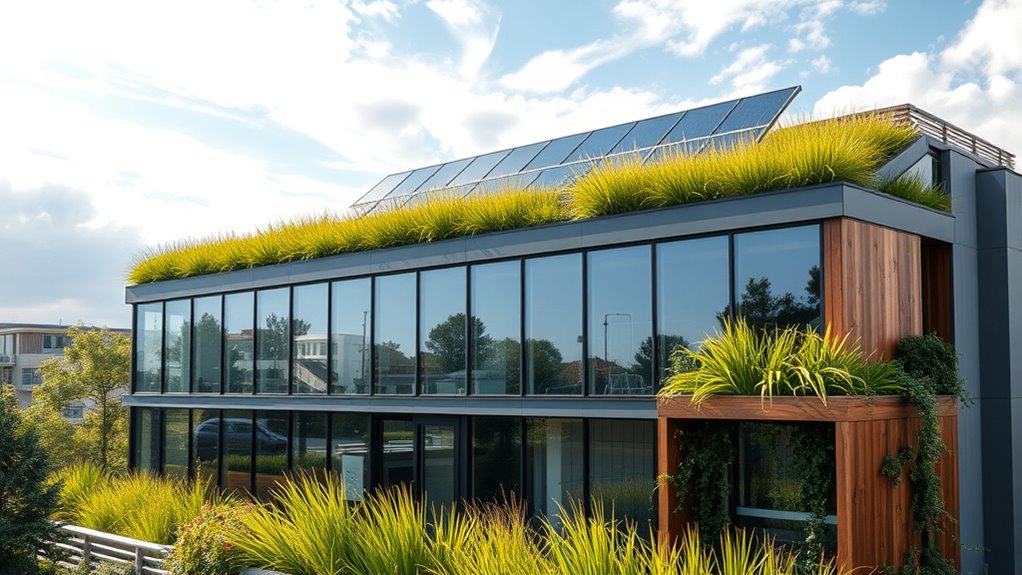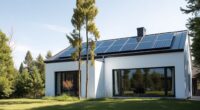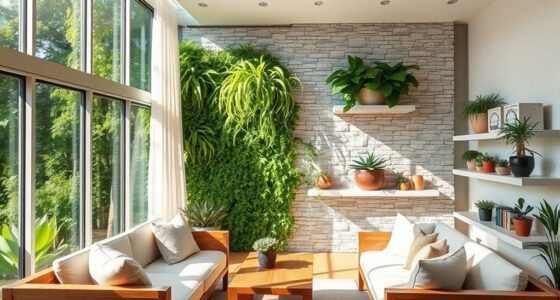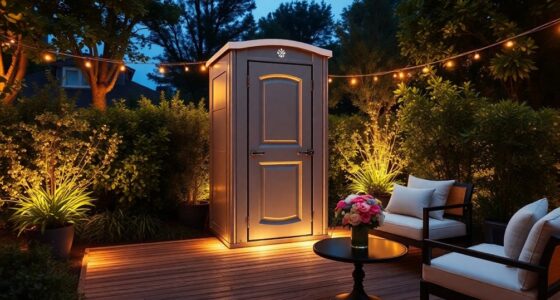Green building focuses on designing structures that are environmentally responsible and resource-efficient throughout their lifespan. You’ll see features like energy-saving systems, sustainable materials, and water conservation strategies. Solar shading, smart systems, and passive design help reduce energy consumption and improve indoor comfort. Using eco-friendly materials and innovative technology also minimizes environmental impact. If you keep exploring, you’ll discover more ways to create sustainable, resilient spaces that benefit both you and the planet.
Key Takeaways
- Green buildings prioritize environmentally responsible design, focusing on reducing energy use, waste, and environmental impact throughout their lifecycle.
- Incorporating solar shading strategies helps control sunlight, lower cooling costs, and improve indoor comfort.
- Energy modeling and simulation optimize building systems for maximum efficiency and sustainability performance.
- Water conservation features like rainwater harvesting and low-flow fixtures enhance resilience and reduce reliance on external water sources.
- Use of sustainable materials, high-performance insulation, and passive design strategies promote durability and eco-friendly architecture.
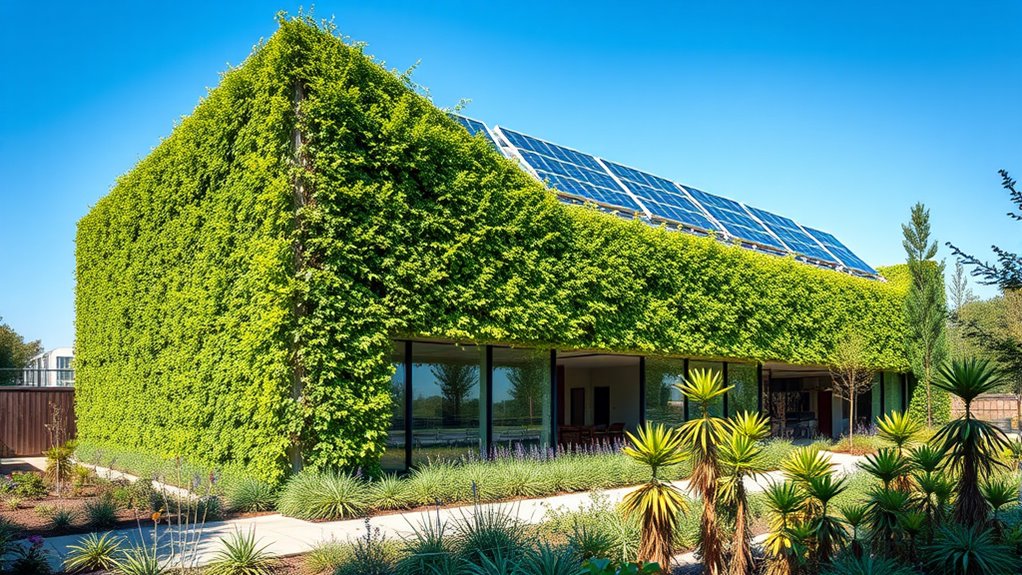
Green building, also known as sustainable design, focuses on creating structures that are environmentally responsible and resource-efficient throughout their lifecycle. When you embrace this approach, you prioritize materials and methods that reduce energy consumption, minimize waste, and promote healthier indoor environments. One of the key features you’ll find in sustainable architecture is the strategic use of solar shading. By incorporating external shading devices like louvers, awnings, or vegetation, you can considerably decrease heat gain from the sun, reducing the need for air conditioning. This not only helps cut energy costs but also lessens your building’s carbon footprint. Proper solar shading takes into account the building’s orientation, local climate, and seasonal sun angles, ensuring you maximize comfort while minimizing energy use.
Strategic solar shading reduces heat gain, cuts energy costs, and enhances indoor comfort in sustainable buildings.
Another vital aspect you should consider is energy modeling. This process allows you to simulate a building’s energy performance early in the design phase. By using advanced software, you can analyze how different design choices impact energy consumption and identify the most efficient solutions before construction begins. Energy modeling helps you optimize insulation, window placement, HVAC systems, and lighting, ensuring that your building operates at peak efficiency. It’s an invaluable tool for making informed decisions that align with sustainability goals, saving you money in the long run and reducing environmental impact. Additionally, integrating resilient design strategies can enhance your building’s ability to withstand climate-related challenges, further supporting sustainability. Incorporating water conservation features like rainwater harvesting and low-flow fixtures complements your efforts to create a truly sustainable space, reducing reliance on external water sources. Furthermore, implementing smart systems that adapt to occupancy patterns can optimize energy use and improve occupant comfort.
In addition to solar shading and energy modeling, sustainable buildings often feature high-performance insulation, energy-efficient windows, and smart systems that adapt to occupancy patterns. These elements work together to maintain comfortable indoor conditions with minimal energy input. You’re encouraged to select renewable or recycled materials whenever possible, further enhancing your building’s eco-friendliness. The design process also emphasizes water conservation, with features like rainwater harvesting and low-flow fixtures, which complement your efforts to create a truly sustainable space. Incorporating innovative materials can further boost the building’s overall sustainability and durability. Exploring passive design strategies can significantly reduce the need for active heating and cooling systems, further lowering energy consumption.
Ultimately, you’ll find that integrating solar shading and energy modeling into your building design not only makes it more environmentally responsible but also more cost-effective and comfortable for occupants. These features exemplify how thoughtful planning and innovative technology can lead to a structure that meets today’s needs without compromising future resources. Sustainable architecture isn’t just about adding green elements; it’s about rethinking how you design, construct, and operate buildings to promote a healthier planet and a better quality of life for everyone involved.
Frequently Asked Questions
What Certifications Define a Building as Sustainable?
When you ask about certifications that define a building as sustainable, you’re looking for recognized standards like LEED certification and WELL standards. LEED evaluates environmental impact, energy efficiency, and resource use, while WELL focuses on occupant health and wellness. These certifications guarantee your building meets rigorous sustainability criteria, making it a responsible choice for the environment and its occupants. Achieving them signals your commitment to sustainable, healthy architecture.
How Does Green Architecture Impact Long-Term Cost Savings?
Think of green architecture as planting a money-saving tree in your building. It boosts energy efficiency and water conservation, which lowers your utility bills over time. By investing in sustainable features now, you save more in the long run, just like watering a tree helps it grow strong and fruitful. Your building becomes more cost-effective, reducing operational costs while helping the environment, making it a smart, future-proof choice.
Are Green Building Materials More Environmentally Friendly?
You might wonder if green building materials are truly more eco-friendly. They often include eco-friendly insulation and recycled construction materials, which reduce waste and lower environmental impact. These materials are designed to minimize resource use and decrease pollution. By choosing them, you help promote sustainability and protect the environment, making your building more sustainable overall. So yes, green building materials are generally more eco-friendly, supporting a healthier planet.
Can Existing Buildings Be Retrofitted to Be More Sustainable?
Yes, you can retrofit existing buildings to be more sustainable. Focus on upgrading the building envelope to improve insulation and reduce energy loss. Use energy modeling to identify areas where efficiency can be enhanced. These improvements help lower energy consumption and carbon footprint, making your building more eco-friendly. Retrofitting not only benefits the environment but can also save you money on energy costs over time.
What Role Do Renewable Energy Sources Play in Green Buildings?
Renewable energy sources play a crucial role in green buildings by reducing reliance on nonrenewable resources. You can incorporate solar panels to harness sunlight and generate electricity, while wind turbines capture wind energy, powering your building sustainably. These features lower energy costs, decrease carbon footprint, and promote environmental responsibility. By integrating solar and wind systems, you make your building more eco-friendly, efficient, and aligned with sustainable architecture principles.
Conclusion
By embracing sustainable design, you become part of a legacy like Da Vinci’s vision—innovative and harmonious with nature. Green buildings aren’t just structures; they’re a proof to your commitment to a healthier planet. As you incorporate key features, remember that each choice echoes the wisdom of those who dreamed of a better world long before us. Ultimately, your dedication to green building helps shape a future where harmony between humanity and nature endures.
